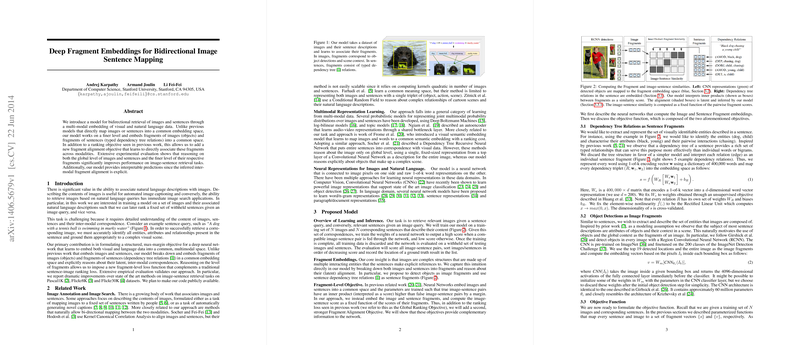Deep Fragment Embeddings for Bidirectional Image Sentence Mapping
In "Deep Fragment Embeddings for Bidirectional Image Sentence Mapping," Karpathy, Joulin, and Fei-Fei present a novel approach for associating visual data with natural language descriptions. The paper explores the intricate task of bidirectional retrieval—identifying images based on descriptive sentences and vice versa—by leveraging a rich, multimodal embedding space.
Core Contribution
The paper introduces a new method that deviates from traditional approaches which directly map whole images or sentences into a common embedding space. Instead, it proposes embedding fragments of images (objects) and fragments of sentences (typed dependency tree relations) into a shared space. This fine-grained decomposition allows for explicit reasoning about the latent alignments between visual and textual fragments, enhancing interpretability and performance in retrieval tasks.
Model Architecture
The proposed model is a deep neural network that comprises several key components:
- Sentence Fragment Embedding: Sentences are broken down into dependency tree relations. Each relation is mapped to an embedding space, leveraging a fixed 400,000-word dictionary for initial word vector representations, with a specific transformation applied to the dependencies.
- Image Fragment Embedding: Images are processed using a Region-based Convolutional Neural Network (RCNN) to detect objects within the image. The detected objects, along with the whole image, are treated as image fragments and mapped to the embedding space using CNN features.
- Fragment-Level Objective: The model introduces a structured max-margin objective that consists of a traditional global ranking objective and a novel fragment alignment objective. The global ranking objective ensures that image-sentence pairs are ranked appropriately, while the fragment alignment objective learns to directly associate specific fragments across modalities.
Results and Evaluation
The model's efficacy was extensively validated on established datasets such as Pascal1K, Flickr8K, and Flickr30K. The experimental results demonstrate the following:
- Improved Retrieval Performance: The proposed method significantly outperforms prior state-of-the-art methods in bidirectional retrieval tasks. For instance, on the Pascal1K dataset, the model achieves a Recall@1 of 39% for image annotation, compared to 25% by the SDT-RNN baseline.
- Complementary Objectives: Combining the global ranking and fragment alignment objectives yields superior performance compared to using either objective alone.
- Importance of Fragmentation: The decomposition of images into object fragments and sentences into dependency relations provides a more nuanced understanding, leading to better retrieval accuracy. Moreover, reasoning at the fragment level enables the model to make more interpretable predictions.
Practical and Theoretical Implications
Practically, the model's ability to associate finer-grained pieces of visual and textual data has immediate applications in image captioning and search. Theoretically, the work underscores the importance of multimodal learning and suggests that capturing inter-modal correspondences at a granular level is beneficial.
Future Directions
Future research could extend this work by exploring counting mechanisms, improving spatial reasoning, and moving beyond the bag-of-fragments approach. Additionally, fine-tuning with larger and more diverse datasets could further enhance the model's generalizability and robustness.
In conclusion, the paper by Karpathy, Joulin, and Fei-Fei significantly pushes the boundaries of image-sentence retrieval by introducing a method that incorporates fragment-level reasoning, setting a new benchmark for both retrieval performance and interpretability in multimodal embedding spaces.
